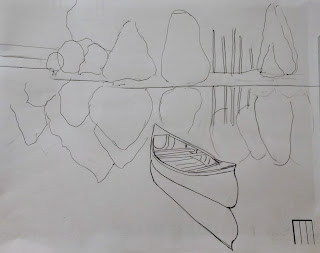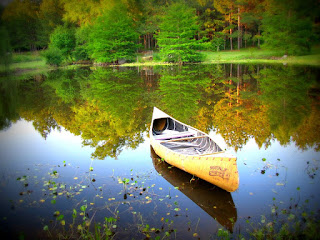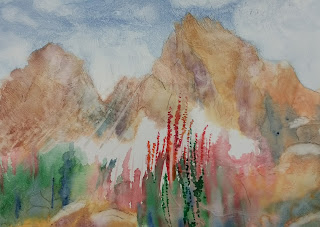EXPERIMENTING WITH REFLECTIONS--STILL WATER
Water has some amazing properties, and painting it can be a challenge. Water reflects light, absorbs light, can let you see objects beneath it. Understanding a few of these properties, along with your own observations, can help make your paintings believable. So, be patient with my little experiments. They really do help simplify things.
First use a mirror and a marker or clothespin. Observe the reflection of the object in several positions: upright, leaning to the left or right; leaning forward, leaning backward. Notice that the length of the reflection changes as you lean it back or forward, and that the angle of reflection is the exact angle of the object in reverse. It may seem obvious, but also notice that the top of the object appears as the bottom of the reflection.
Also, in this picture my line of vision is quite close. Try moving closer and farther from the mirror to see how much the reflection changes.
Take the marker off the mirror and move it onto the table a small distance away from the mirror. How much of the marker is reflected?
Often, we think it is reflecting exactly what we see. But think about lying face up und
erneath the water. What you see from there may be the underneath side of a pier, not the top.
This experiment shows color and value of reflections.
Water color is influenced by several factors: The actual color of the water; the color of the sky; minerals that might be in the water; and the bottom of the stream or lake, depending on the depth of the water; and pollution and other particles. So the color of your reflections are influenced by all of these.
I tried to imitate a green color of water with the bowl. The reflection of the white cup is darker and greener than the cup itself. But we also discovered that the reflection of something black is LIGHTER than the object. Try other colors of objects and see what happens.
COLOR of the reflection depends on color of water/sky/etc. VALUE of the reflection depends on the cleanliness of the water and the value of the object. Also, distance comes into play. If an object is close to you, and you are looking down at it, the reflection is probably darker than if the object was farther away and you were looking at it at a different angle. Dirty water tends to reflect lighter than the object in general.
So here is a little exercise. Top Left is three poles in the water at different angles. Reflections are darker. To the right of that is three poles, same angles, only in dirty water. Reflections are lighter. On the bottom left are three poles facing away from you. Their reflections will be shorter, if they are there at all. Check your mirror experiment. Right of that is three poles foreshortened and facing toward you. The reflections look longer. They are reflecting the underneath side of those poles that your eye doesn't see.
On the far right, I was demonstrating making a wash for my first layer of water. Painting upside down, with my board at a slight tilt, I wet the body of water to the horizon line, and made a wash from dark to light. (I used french ultramarine, cobalt, and a little burnt umber to make it darker.) WATER IS GENERALLY OPPOSITE OF SKY. Sky is darker at the top, lighter toward the horizon. Water is darker at the bottom (toward you) and lighter toward the horizon. This has to do with aerial perspective and how the sky is reflected in the water.


So this is the reference that I got from Pixabay.com. It's a very good example of very still water and nearly perfect reflections. Notice a few things that I've already mentioned. #1: The reflection of the canoe is much darker than the canoe itself. It is a combination of the yellow canoe and the color of the water. You only see the underside of the canoe. It is darker near the canoe, because that is in shadow, which would be darker. It is also darker because it is close to the viewer. Also, the canoe reflection is pretty hard edged because there are no ripples in the water.
The reflections of the trees are precise, but not as hard edged.
One more thing to notice. there is a stand of tree trunks on our right. They are set back off the shore. The trees that come to the shore edge are completely reflected. But the trees set back a little have only part of their trunks reflected.
To start the painting, I used contact paper to white out the canoe. (to use contact paper, see the turtle demo) Then, holding the paper upside down at a tilt, I painted in the calm water. (French Ultramarine, cobalt, and a bit of burnt umber in the darkest part) I made a gradual wash, ending with almost pure white paper at the edge of the lake.
I painted the shadow of the canoe using raw sienna and some of the water color. (Yellow of canoe + blue of water would make a greenish color) If the canoe were red, I would have made the reflection red + some blue of the water + some color to dull the red a bit.)
You can start your painting with either painting the reflections first or the trees first. I chose to do the reflections first. I wanted to keep them soft edged, so I wet the sections I wanted to paint first, painting wet into wet, and softening the edges as I painted. This is as far as I've gone, but I wanted to at least get this much posted, since we are working more on this next week.
STARTING TO PAINT RIPPLED WATER
I chose this reference for a reason. First, the water is not a pure clean color. Second, the reflection is distorted slightly because of the ripples in the water. This also came from Pixabay. Remember, when using a photo that you did not take, even if it's from a copyright free site, this is just for your practice. If it is not my photo, I don't enter it into shows or put it up for sale without written permission to use it.
This water is started the same as the other, upside down and tilted for a wash that blends better, but there is no horizon line. I used contact paper to white out the boat first, and some miskit on the rope and on the white wiggles in the reflection. The difference is that I wanted the water to look darker and greener, so in addition to the blues, I have added some raw umber and burnt umber.
MORE ON RIPPLE NEXT POST.




















































